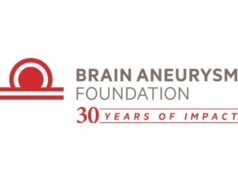
A lack of overall understanding regarding rupture risks is one of the most notable challenges impeding the successful treatment and management of brain aneurysms—and therefore also represents one of the most pressing unmet needs faced by these patients. In a guest piece for NeuroNews, Diederik Bulters (Southampton, UK) lays out the scope of this challenge and outlines how the UK Risk of Aneurysm Rupture (ROAR) study is attempting to provide some much-needed answers.
Deciding with your patient whether or not to treat an unruptured intracranial aneurysm remains one of the most common clinical scenarios faced by neurovascular specialists. It is unlikely to have a single, uniform answer applicable to everyone, and it is therefore not a question that can be addressed by a randomised trial—even in the unlikely event that sufficient buy-in could be found, from both patients and clinicians, to undertake one.
As such, it is likely that, for most of our careers, treatment decisions will continue to be made based on our understanding of the natural history of aneurysms.
On the face of it, there is a lot known about this, and studies like ISUIA and PHASES were step changes in our understanding of how to manage the condition. Despite this, there remain many uncomfortable contradictions in the available data that are difficult to reconcile and difficult to explain to patients.
Existing evidence
When we first started thinking about this problem, we took things back to basics and asked: what is it that patients want from our risk prediction models? And does our existing evidence satisfy these requirements? Our conclusion was that they want three things: models that are accurate, personalised, and long term (ideally lifetime).
If we assess what we have, it is hard to claim that we are sure our risk predictions are accurate, when the available studies all give conflicting estimates. At the extremes, we have the ISUIA and Finnish studies. ISUIA showing a 0% risk of a small aneurysm rupturing is in stark contrast to the Finnish data showing a 26% rupture risk at 30 years.
Whichever study we opt to use, we must make significant assumptions. Using ISUIA, we have to assume that the 72% of patients treated—including the ones that did not enter the trial’s conservative management arm—were treated at random. That is to say there was no selection based on features that may alter rupture risk that were not accounted for in the analysis (for example, aneurysmal blebs or family history). The Finnish data are subject to essentially no treatment or follow-up bias, and they are therefore very attractive to adopt—even if they came from only 142 patients. However, to use these data, we have to assume there are no differences in rupture risk between populations.
It is worth mentioning that there is also a third source of data. This comes from Japan and actually provides the largest dataset by some margin. It also has higher rates of rupture than ISUIA. This is particularly unfortunate given Japan is also the only country other than Finland hypothesised to have different rupture rates from the rest of the world. It leaves clinicians outside of Japan and Finland with the difficult decision of whether to use the most representative population (ISUIA), the data with the least bias (Finland), or the largest dataset (Japan).
The PHASES meta-analysis, in many ways, set out to resolve this. However, in choosing to include Finland or Japan, or neither, as one of the predictors, it has made the assumption that the differences in rupture risk are due to differences in populations, and not study methodology and consequent biases. In truth, we do not know whether the differences are due to differences in populations or methodology, and therefore PHASES does not really resolve the issue that we do not know which estimates are accurate for our patients.
In addition to questions about accuracy, it is also questionable to what degree our estimates are personalised. Most of the studies have provided risk estimates based on a couple of factors—mostly aneurysm size and location. This is largely due to power limitations posed by low event rates. Even PHASES only considers six features, and does not consider things like family history or aneurysm shape. It is very difficult to persuade a patient with two first-degree relatives who have had a subarachnoid haemorrhage (SAH) that this should not be weighed up when deciding whether or not to treat their aneurysm!
And perhaps the biggest issue is that of long-term risk. A typical female patient presenting at 50 years of age has a life expectancy of nearly 40 years. The median length of follow-up in PHASES was just one year. To use this, we need to extrapolate. This assumes risk is constant over time—however, we simply do not know if this is the case. Some clinicians believe aneurysms are most at risk early after diagnosis, whereas PHASES suggests that they are riskier in older age. Even if the risk of rupture does not change over time, just tiny differences in one-year risk make huge differences in lifetime estimates.
There are real, practical barriers to resolving these issues. To study rupture risk, you need a large study population consisting of thousands of patients, due to low event rates. To personalise estimates, you need to increase sample sizes much further, to tens of thousands of patients. You then need to find ways to follow up such a large cohort in the long term while also minimising follow-up biases.
ROAR study
We designed the ROAR study to overcome these barriers and address those three fundamental requirements that we identified at the outset: that data are accurate, personalised and long term.
We have done this by linking local neurosurgical records, and national databases of hospital admissions and deaths from NHS Hospital Episode Statistics (HES) and the UK Office for National Statistics (ONS). In the UK, almost all patients found to have aneurysms will be discussed with a neurosurgeon—and we have used this to collect detailed baseline clinical data on more than 20,000 patients with unruptured aneurysms.
We are also fortunate to have a single national database of admissions and deaths. While the level of detail on these is limited, the data are perfect for detecting events of SAH that will always lead to hospital admission or death. If used as a screening tool for aneurysm rupture, we have demonstrated they can help to detect 95.8% of events, rising to 98.2% when used in combination with neurosurgical records, and can be used to follow up patients indefinitely.
We have been very lucky to initially obtain funding from local charities—including Smile4Wessex and the Polycystic Kidney Disease (PKD) charity—to pilot this work and subsequently secure funding from the Royal College of Surgeons and National Institute for Health and Care Research (NIHR) in the UK for the full study.
We have baseline data on over 20,000 patients. We have linked the first 10,000 patients to HES/ONS data, and the remaining 10,000 are currently undergoing linkage by NHS England. Over the next year, all cases of aneurysm rupture will be manually validated before—hopefully—we are able to report first results in autumn 2025.
Going forward, we hope to secure recurrent funding to search the cohort against HES/ONS data every five years, in order to update our evidence base with rupture risk timeframes of increasing lengths. We also want to link to the three systems of general practitioner (GP) records used in the UK to study time-dependent variables—including medication, blood pressure and hormones—and we are pulling magnetic resonance imaging (MRI) scans from the cohort for image analysis. Furthermore, with the assistance of Hereditary Brain Aneurysm (HBA) Support and the International Stroke Genetics Consortium, we are making applications to obtain saliva samples from the cohort, to aid with DNA extraction and genotyping.
We therefore hope, in time, to be able to provide what our brain aneurysm patients need: accurate, personalised lifetime estimates of rupture risk.
Diederik Bulters is a consultant neurosurgeon and professor of neurosurgery at University Hospital Southampton in Southampton, UK. He also served as president of the British Neurovascular Group from February 2019 to November 2021. Bulters is the chief investigator for the ROAR study—a UK-based, multicentre research project aiming to enhance the current understanding of brain aneurysm rupture risks.









